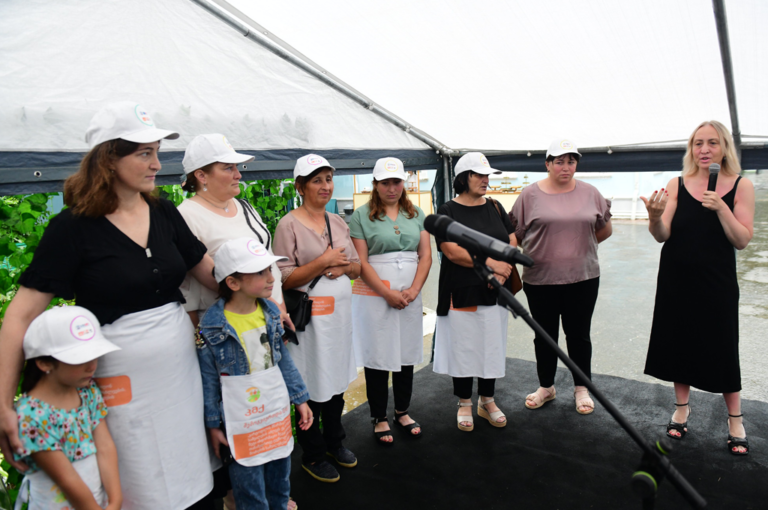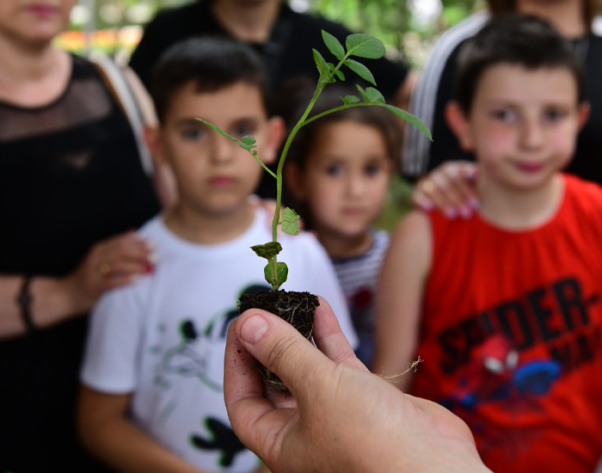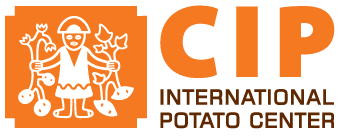კარტოფილს შესაძლოა საქართველოში „მეორე პურის“ სახელით იცნობენ, თუმცა ქვეყანაში კარტოფილის საშუალო მოსავლიანობა მის პროდუქტიულ პოტენციალზე გაცილებით დაბალია. ეს ხარვეზი დიდწილად გამოწვეულია ფერმერების მიერ დაბალი ხარისხის სათესლე კარტოფილის დათესვით. ამიტომ CGIAR კარტოფილის საერთაშორისო ცენტრი (CIP) თანამშრომლობს მცირე ფერმერებთან, სამთავრობო ინსტიტუტებთან, საქართველოს ფერმერთა ასოციაციასთან და კერძო საწარმოებთან, რათა ფერმერებისათვის შესაბამისი აგრონომიული სწავლების ტრენინგების ჩატარების პარალელურად შექმნას გამართული სათესლე სისტემის მექანიზმი ჯანსაღი კარტოფილის წარმოებისთვის.
საქართველოში USAID-ის კარტოფილის პროგრამის ფარგლებში, CIP-მა ხელი შეუწყო მეცნიერებაზე დაფუძნებული მიდგომების დანერგვას მამაკაც და ქალ ფერმერებს შორის, რამაც ხელი შეუწყო ფერმების პროდუქტიულობის, კვების უსაფრთხოებისა და შემოსავლების ზრდას. ბოლო ორი წლის განმავლობაში პროგრამა დაეხმარა 2,300-ზე მეტ მცირე ფერმერს ინოვაციური ტექნოლოგიების და შესაბამისი სამეურნეო პრაქტიკის დანერგვაში. ბევრი მათგანი აგრძელებს განვითარებას და ყიდის ხარისხიან სათესლე კარტოფილს და აძლიერებს როგორც სხვა ფერმების, ასევე საკუთარ წარმოებას.
პროგრამის მონაწილეებმა, რომელთაგან ნახევარი ქალია, ხარისხიანი სათესლე კარტოფილისა და კარგი პრაქტიკის გამოყენება დაიწყეს. შედეგად მათი მოსავალი გაორმაგდა. აღნიშნული პრაქტიკის გავრცელების მიზნით CIP ადგილობრივ პარტნიორებთან სამი თაობის (3G) მიდგომის დასანერგად მუშაობდა. აღნიშნული მიდგომა ამცირებს სერტიფიცირებული სათესლე კარტოფილის მოსავლის წარმოებისთვის საჭირო დროს ხუთიდან სამ წლამდე. ზემოაღნიშნული ხელს შეუწყობს არამარტო კარტოფილის მწარმოებელი ფერმერების დაინტერესებასა და მაღალპროდუქტიული თესლის წარმოებას, არამედ გააუმჯობესებს ფერმერების საარსებო შემოსავლებსა და სასურსათო უსაფრთხოებას.
ზემოაღნიშნული ასევე უზრუნველყოფს სერტიფიცირებული სათესლე კარტოფილის წარმოების პროგრამაში ჩართული და დარეგისტრირებული ფერმერებისთვის დამატებითი შემოსავლების წარმოშობის შესაძლებლობებს. სასურსაათო კარტოფილის ჯიშებთან შედარებით სერტიფიცირებულ სათესლე კარტოფილს უფრო მაღალი საბაზრო ღირებულება გააჩნია.
პროგრამა დაეხმარა ფერმერ ქალბატონებს კოოპერატივ „კარტოფილის მწარმოებელთა ქსელის“ ჩამოყალიბებაში. ისინი გადამზადნენ კარგი ფერმერული პრაქტიკებისა და ინოვაციების დანერგვისა და აღნიშნული ინოვაციებისა და პრაქტიკების სხვა ფერმერებისთვის გაზიარების მიზნით.
აღნიშნული წარმოადგენს USAID-ის კარტოფილის პროგრამის ერთერთ უმნიშვნელოვანეს მიღწევას, რომელიც მოიცავს შემდეგს:
- 4000-ზე მეტი ფერმერის მიერ ხარისხიანი სათესლე კარტოფილის გამოყენების სარგებლიანობის გაცნობიერებას;
- სამოდელო მეურნეობის ჩამოყალიბებას პირველადი სათესლე მასალის საწარმოებლად, რომელსაც სერტიფიცირებული სათესლე კარტოფილის შემდგომი წარმოებისთვის კომპანიები და ფერმერები შეიძენენ;
- ტრადიციულად, ძირითად სასოფლო-სამეურნეო ბაზრებზე წვდომის არმქონე ქალებისა და ახალგაზრდების მიერ სათესლე კარტოფილის წარმოების, როგორც სიცოცხლისუნარიანი ბიზნესის დემონსტრირებას;
- იმ ფერმერების მიერ პროგრამის ფარგლებში წარმოებული ხარისხიანი თესლის გამოყენებას, რომელმაც მნიშვნელოვნად გაზარდა გაყიდვები 150 %-ით.
თესლწარმოების პროცესის დაჩქარებისა და ზრდისთვის შეიქმნა დაფესვიანებული აპიკალების გამოყენების ინოვაციური ტექნოლოგია, მცენარეული ქსოვილიდან აღებული მასალის გადამრავლებით კარტოფილის ჩითილების საწარმოებლად და უფრო მეტი სათესლე კარტოფილის მისაღებად.
მარნეულის მუნიციპალიტეტში 11 ქალბატონისგან შემდგარმა ჯგუფმა აპიკალური ჭრის ტექნოლოგია წარმატებით აითვისა და „სათესლე კარტოფილის მწარმოებელთა ქსელი“ დააფუძნა, რომელმაც 2022 წლის პირველ ნახევარში 300 000 ცალი კარტოფილის ჩითილი აწარმოა. აღნიშნული ჩითილების რეალიზაცია საქართველოს სხვადასხვა რეგიონებში მოხდა. ისინი ფერმერებმა შეიძინეს და საკუთარ ნაკვეთებში გადარგეს. ამის პარალელურად, კომპანია „მარნეული აგრომ“ სამი ჰექტარი ტერიტორიისთვის სამყოფი ჯანსაღი სათესლე მასალა მიიღო, საიდანაც 90 ტონა სერტიფიცირებული სათესლე კარტოფილის წარმოება არის შესაძლებელი. მიღებული პროდუქციის რეალიზაცია ფერმერებისთვის 2023 წლის გაზაფხულზე არის დაგეგმილი.
USAID-ის კარტოფილის პროგრამას ჰქონდა როგორც უამრავი წარმატება, ასევე გამოწვევებიც. კერძოდ, 2022 წლის გაზაფხულზე, სამცხე-ჯავახეთის რეგიონისთვის დასაწყობებული დიდი რაოდენობით სათესლე კარტოფილის გაყინვის ფაქტი, რაც ადგილობრივი ფერმერებისთვის გახდა იმედგაცრუებისა და ზარალის მიზეზი. მიუხედავად ამისა, სამცხე-ჯავახეთი კვლავ რჩება პროგრამის პრიორიტეტულ რეგიონად, კარტოფილის უხვი მოსავლის წარმოების დიდი პოტენციალით, რადგანაც სწორედ აქ იწარმოება ხარისხიანი და ჯანსაღი სათესლე კარტოფილი.
ხარისხიანი სათესლე კარტოფილის წარმოებაში უახლესი ტექნოლოგიების დანერგვით, კვალიფიციური ექსპერტების გუნდის გადამზადებითა და სერტიფიცირებული სათესლე მასალის გამოყენების მნიშვნელობის შესახებ ფერმერების ცნობიერების ამაღლებით USAID-ის კარტოფილის პროგრამამ საფუძველი ჩაუყარა საქართველოში სათესლე კარტოფილის ეროვნული სექტორისა და სათესლე სისტემების ჩამოყალიბებას, რომელიც ჯანსაღი მაღალხარისხიანი სათესლე კარტოფილის მწარმოებელ ქვეყნებში მოქმედი სათესლე სისტემების ექვივალენტური იქნება.
The potato may be known as the “second bread” in Georgia, but the country’s average potato yield is well below the crop’s productive potential. This gap is largely due to farmers planting low quality seed potatoes, which is why the CGIAR International Potato Center (CIP) has partnered with small-scale farmers, government institutions, the Georgian Farmers Association, and private enterprises to build a seed system to produce healthy potato planting material, while providing farmers with agronomic training.
Under the USAID Potato Program in Georgia, CIP has promoted science-based approaches to boost farm productivity, nutrition security and incomes among men and women farmers. The program has helped more than 2,300 smallholders adopt innovative technologies and appropriate farming practices over the past two years, and many of them now grow and sell quality seed potatoes, boosting the production of other farms as well as their own.

Participants who began using quality seed potatoes and good practices, half of whom are women, have more than doubled their yields. To extend such benefits to more smallholder families, CIP has worked with local partners to introduce a three-generation (3G) approach that reduces the time it takes to produce a crop of certified seed potatoes from five years to three. This will not only provide a growing number of potato farmers with high yielding seed, which can improve their livelihoods and food security, it also creates income opportunities for farmers who learn and register to grow certified seed potatoes, which have a higher market value than table potatoes.
The Program helped a group of women farmers form a Potato Producers’ Network and provided them with training, so they can share good farming practices and innovations with others. It is just one the Potato Program’ varied achievements, which include:
- More than 4000 farmers made aware of the benefits of using quality seed potatoes.
- Establishment of a model farm that produces starter seed that is sold to companies and farmers who grow it to produce certified seed potatoes.
- Demonstration that potato seed production can be a viable business for women and youth, who have traditionally lacked access to major agricultural markets.
- Farmers who have planted quality seed produced under the Program increased their sales by 150%.

One innovation adopted to expand and accelerate seed production is the use of rooted apical cuttings, tiny seedlings grown from plant tissue cuttings that produce more potatoes more quickly than plants grown from tubers. One group of 11 women in Marneuli Municipality, in southern Georgia, trained in the apical cutting technology, formed a seed potato multiplier unit. Together, they produced 300,000 seedlings in first half of 2022, which they sold to farmers in various potato growing areas or planted on their own farms. At the same time, the company Marneuli Agro planted three hectares with disease-free potatoes to produce about 90 tons of certified seed potatoes, which will be sold to farmers in the spring of 2023.
While the Potato Program has had varied success, it has also encountered challenges. An unseasonal frost froze a large amount of seed potatoes stored for planting in the spring of 2022 Samtskhe-Javakheti Region, which was a frustrating loss for local farmers. Nevertheless, Samtskhe-Javakheti remains a priority region for the Program, with great potential to produce bountiful potato harvests as the production and use of quality seed increases there.
By training a growing number of experts in the production of quality potato seed, transferring the latest technologies, and raising farmer awareness of the importance of using certified seed, the USAID Potato Program is laying the foundation of a national potato seed sector that can help Georgia establish seed systems comparable to those of the world’s top potato producing countries.
